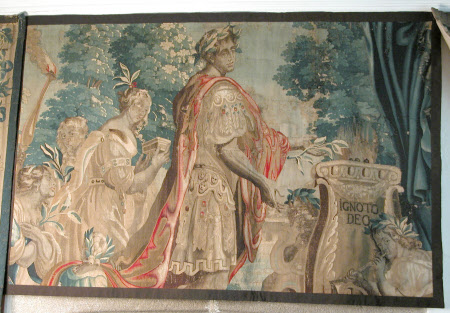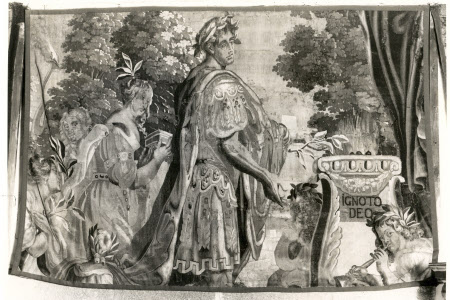Caesar Augustus
Jan Frans Cornelissen (d.1678)
Category
Tapestries
Date
circa 1670 - circa 1685
Materials
Tapestry, wool and silk, 6 warps per cm
Place of origin
Antwerp
Order this imageCollection
Cotehele, Cornwall
NT 348293
Summary
A set of two tapestries of the History of Caesar Augustus, tapestry, wool and silk, 6 warps per cm, Antwerp, Jan Frans Cornelissen or Maria Anna Wauters after a design by Justus van Egmont, c. 1670-1685.
Full description
Caesar Augustus was the first Emperor of Rome from 27 BC until his death in 14 AD. Born Gaius Octavius Thurinus, he was the great nephew and heir of Julius Caesar whose name he adopted. After defeating first the murderers of Julius Caesar, and then Mark Antony, from 31 BC he was effectively sole ruler of Rome. In 27 BC he established the Pricipate and assumed the role of Emperor, taking the name Augustus which was used by all subsequent Roman Emperors. Caesar Augustus based his extensive personal power on the outward traditions and forms of the old Roman Republic, but he would never restore the Republic’s democratic liberties which he believed had led to the infighting of the last two generations. His reign saw a large program of social reform and reconstruction, the creation of Rome’s first standing army (which was under the Emperor’s personal control), and the consolidation of the boundaries of the Empire after lengthy conflict in Germany. Caesar Augustus was a patron of poets such as Horace and Virgil, and literature and the arts flourished under his rule. Of the two ‘Caesar Augustus’ tapestries at Cotehele the ‘Sacrifice to the Unknown God’ no longer has any borders, but ‘Caesar Augustus Conferring the Laurel Wreath on Tiberius’ still has most of its upper and right-hand borders, which are of a type found on most of the surviving examples of the ‘Caesar Augustus’ series. The side border includes at the bottom part of a silver urn, and in the middle a bronze figure of Victory holding a laurel wreath and a pole with a red flag inscribed ‘SPQR’ for Senatus Populusque Romanum’ (‘The Senate and the People of Rome’), the motto of the city of Rome. Above is a military trophy and an Imperial eagle in a laurel wreath, a plaque affixed to it inscribed ‘VIC AV[G]’ (the G partially obscured) for ‘Victoria Augusti’ or ‘The Victory of Augustus’. The missing left hand border would have included a figure of Peace and the inscription ‘PAX AVG’ (‘The Peace of Augustus’). The abbreviations 'VIC AVG and PAC AVG' frequently used on Roman Imperial coins. ‘The History of Caesar Augustus’ was almost certainly woven in the Antwerp workshop of Jan Frans Cornelissen (fl. 1659 – d. 1678). The records of the art dealers the firm Forchoudt contain references to Caesar Augustus tapestries in their correspondence with Cornelissen from 1669 onwards (Denucé 1931, pp. 112-113). On Cornelissen’s death in 1678 his workshop stock and tapestry cartoons passed to his relative Michiel Wauters, and when Wauters died the following year to his daughter Maria Anna Wauters (d. 1703). Maria Anna continued to weave tapestries from the ‘Caesar Augustus’ cartoons, and her correspondence with the branch of the Forchoudt firm in Vienna contains references to ‘Caesar Augustus’ tapestries in 1685 and 1688. A version of the ‘Sacrifice to the Unknown God’ formerly at Hallingbury Place bears the signature of a third weaver, Philip Wauters (fl. 1660 – d. 1679), Michael Wauters's brother (Marillier 1930, plate 5a). It is probable that Philip Wauters and Cornelissen collaborated by sharing the cartoons for the set, or that they were leased from one weaver to the other. The two panels at Cotehele could therefore have been made at one of three different workshops, although it is more probable that they were made by either Cornelissen or Maria Anna Wauters. There is no evidence as to the designer of the ‘Caesar Augustus’ series, but the set has been attributed on stylistic grounds to Justus van Egmont (Forti-Grazzini 1994, p. 342). It is probable that the designs were executed in 1659-60, as Cornelissen commissioned a series of ‘Caesar Augustus’ cartoons from an unspecified artist on 31 March 1659 (Crick-Kuntziger 1950, p. 16). Numerous examples of tapestries from the 'Caesar Augustus' series survive in Britain, where they seem to have been especially popular, and elsewhere in Europe. The only complete set of eight is in the Austrian State collection, and includes the following subjects: ‘Azia Reading the Will of Julius Caesar to her son Caesar Augustus’; ‘Octavia Reconciling Augustus and Mark Anthony’; Cleopatra before Caesar Augustus’; ‘Battle between the Romans and the Germans’; ‘Augustus Conferring the Laurel Wreath on Tiberius’; ‘The Liberality of Augustus to his Soldiers’; ‘Sacrifice to the Unknown God’; and ‘The Vestals giving the Will of Augustus to the Senate’ (Birk 1884, p. 189). The set in Vienna has borders identical to a ‘Numa Pompilius’ tapestry at Cotehele, also made by either Jan Frans Cornelissen or Maria Anna Wauters (348295). All the other known versions of the ‘Caesar Augustus’ series have the ‘PAX AVG / VIC AUG’ borders found on ‘Caesar Augustus Conferring the Laurel Wreath on Tiberius’ at Cotehele (Forti-Grazzini 1994, pp. 341-2). Other sets recorded in England include two panels at Boughton House (Hefford 1992, p. 100), a series of fragments at Hardwick Hall, and at least four other partial sets, whose existence attests to the popularity of the subject in this country, and to the extensive English market catered to by Antwerp tapestry producers in the late seventeenth century (Marillier 1930, pp. 15-17). The set has been at Cotehele since at least c. 1840, when the Rev. Arundell mentioned “another piece [of tapestry] finely executed, of which the subject is a sacrifice, and seems to refer to the story of Diana and Endymion” in the ‘Best Bedroom’, as the South Room was then called (Arundell 1840, p. 27). (Helen Wyld, 2010)
Provenance
Left at Cotehele when the property was accepted in lieu of tax from Kenelm, 6the Earl of Mount Edgcumbe (1873-1965) and transferred to the National Trust in 1947; amongst the contents accepted in lieu of estate duty by H M treasury and transferred to the National Trust in 1974.
Credit line
Cotehele House, The Edgcumbe Collection (The National Trust)
Makers and roles
Jan Frans Cornelissen (d.1678), workshop Maria Anna Wauters (c.1656 - 1703), workshop Justus van Egmont (Leyden 1601 - Antwerp 1674), designer
References
Delmarcel, 1999: Guy Delmarcel, Flemish Tapestry, Tielt 1999 Forti-Grazzini, 1994: Nello Forti-Grazzini, Gli Arazzi (Il patrimonio artistico del Quirinale), 2 vols., Rome 1994 Hefford, 1992: Wendy Hefford, 'Ralph Montagu's Tapestries', in Tessa Murdoch (ed.), Boughton House, the English Versailles, London 1992 Hefford, 1991: Wendy Hefford, The Cotehele Tapestries, The National Trust, 1991 (n.p.) Marthe Crick-Kuntziger, ‘La Tenture de l’Histoire de Zenobie, reine de Palmyre’, Bulletin des Musées Royaux d’Art et d’Histoire, vol. IV, no. 22 (1950), pp. 11-26 Denucé, 1931: Jean Denucé, Kunstuitvoer in de 17e eeuw te Antwerpen: de firma Forchoudt, Antwerp 1931 Marillier, 1930: Henry C Marillier, English Tapestries of the Eighteenth Century, London 1930 Birk 1884 Ernst Ritter von Birk, ‘Inventar der im Besitze des Allerhöchsten Kaiserhauses befindlichen Niederländer Tapeten und Gobelins’, Jahrbuch der kunsthistorischen Sammlungen des Allerhöchsten Kaiserhauses, II (1884), pp. 167-220

